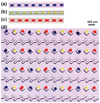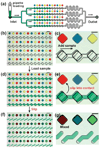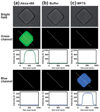SlipChip
- PMID: 19636458
- PMCID: PMC2719824
- DOI: 10.1039/b908978k
SlipChip
Abstract
The SlipChip is a microfluidic device designed to perform multiplexed microfluidic reactions without pumps or valves. The device has two plates in close contact. The bottom plate contains wells preloaded with many reagents; in this paper plates with 48 reagents were used. These wells are covered by the top plate that acts as a lid for the wells with reagents. The device also has a fluidic path, composed of ducts in the bottom plate and wells in the top plate, which is connected only when the top and bottom plate are aligned in a specific configuration. Sample can be added into the fluidic path, filling both wells and ducts. Then, the top plate is "slipped", or moved, relative to the bottom plate so the complementary patterns of wells in both plates overlap, exposing the sample-containing wells of the top plate to the reagent-containing wells of the bottom plate, and enabling diffusion and reactions. Between the two plates, a lubricating layer of fluorocarbon was used to facilitate relative motion of the plates. This paper implements this approach on a nanoliter scale using devices fabricated in glass. Stability of preloaded solutions, control of loading, and lack of cross-contamination were tested using fluorescent dyes. Functionality of the device was illustrated via crystallization of a model membrane protein. Fabrication of this device is simple and does not require a bonding step. This device requires no pumps or valves and is applicable to resource-poor settings. Overall, this device should be valuable for multiplexed applications that require exposing one sample to many reagents in small volumes. One may think of the SlipChip as an easy-to-use analogue of a preloaded multi-well plate, or a preloaded liquid-phase microarray.
Figures






Similar articles
-
User-loaded SlipChip for equipment-free multiplexed nanoliter-scale experiments.J Am Chem Soc. 2010 Jan 13;132(1):106-11. doi: 10.1021/ja908555n. J Am Chem Soc. 2010. PMID: 20000708 Free PMC article.
-
Microfluidic SlipChip device for multistep multiplexed biochemistry on a nanoliter scale.Lab Chip. 2019 Oct 7;19(19):3200-3211. doi: 10.1039/c9lc00541b. Epub 2019 Aug 23. Lab Chip. 2019. PMID: 31441477 Free PMC article.
-
SlipChip for immunoassays in nanoliter volumes.Anal Chem. 2010 Apr 15;82(8):3276-82. doi: 10.1021/ac100044c. Anal Chem. 2010. PMID: 20334360 Free PMC article.
-
Microfluidic cartridges preloaded with nanoliter plugs of reagents: an alternative to 96-well plates for screening.Curr Opin Chem Biol. 2006 Jun;10(3):226-31. doi: 10.1016/j.cbpa.2006.04.004. Epub 2006 May 3. Curr Opin Chem Biol. 2006. PMID: 16677848 Free PMC article. Review.
-
Microfluidic chemical analysis systems.Annu Rev Chem Biomol Eng. 2011;2:325-53. doi: 10.1146/annurev-chembioeng-061010-114215. Annu Rev Chem Biomol Eng. 2011. PMID: 22432622 Review.
Cited by
-
Emerging microfluidic technologies for microbiome research.Front Microbiol. 2022 Aug 16;13:906979. doi: 10.3389/fmicb.2022.906979. eCollection 2022. Front Microbiol. 2022. PMID: 36051769 Free PMC article. Review.
-
Population transcriptomics with single-cell resolution: a new field made possible by microfluidics: a technology for high throughput transcript counting and data-driven definition of cell types.Bioessays. 2013 Feb;35(2):131-40. doi: 10.1002/bies.201200093. Epub 2012 Dec 27. Bioessays. 2013. PMID: 23281054 Free PMC article.
-
Reconfigurable microfluidic dilution for high-throughput quantitative assays.Lab Chip. 2015 Jun 21;15(12):2670-9. doi: 10.1039/c5lc00432b. Lab Chip. 2015. PMID: 25994379 Free PMC article.
-
Challenges and perspectives in the application of isothermal DNA amplification methods for food and water analysis.Anal Bioanal Chem. 2019 Mar;411(9):1695-1702. doi: 10.1007/s00216-018-1553-1. Epub 2019 Jan 8. Anal Bioanal Chem. 2019. PMID: 30617408 Free PMC article.
-
Integrated microfluidic systems with sample preparation and nucleic acid amplification.Lab Chip. 2019 Sep 7;19(17):2769-2785. doi: 10.1039/c9lc00389d. Epub 2019 Jul 31. Lab Chip. 2019. PMID: 31365009 Free PMC article. Review.
References
Publication types
MeSH terms
Substances
Grants and funding
LinkOut - more resources
Full Text Sources
Other Literature Sources

